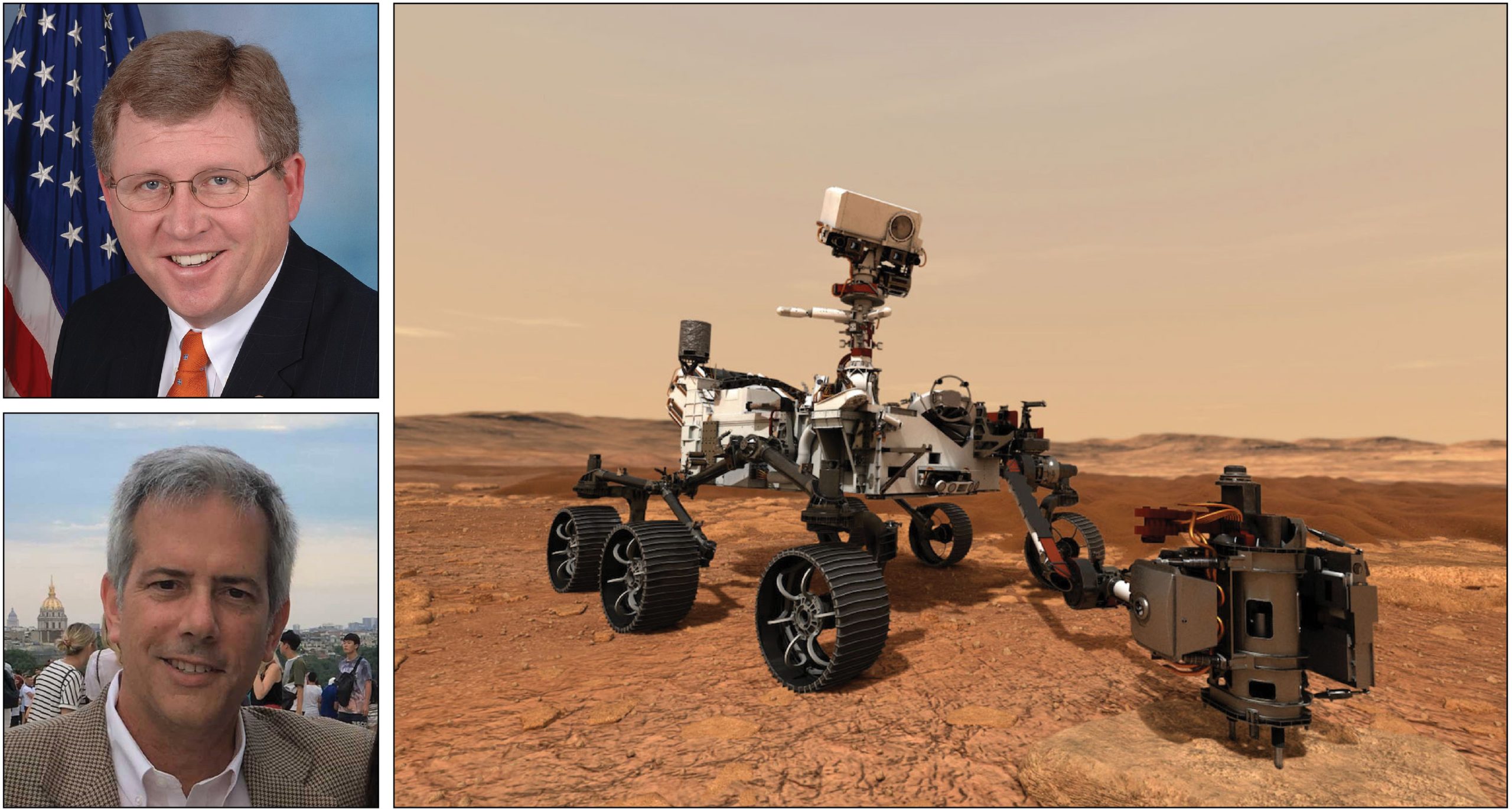
Lucas & Wallace Discuss Mars Perseverance Rover & U.S. Effort to Explore the Red Planet
WASHINGTON, DC — With the Perseverance Rover continuing to make history as it explores the surface of Mars, The Ripon Society and the Franklin Center hosted a virtual discussion this past Wednesday with two leaders who are critical to the mission’s – and the U.S. Space Program’s – success.
The leaders are Frank Lucas and Matt Wallace. Lucas serves as the Republican Leader of the Science, Space and Technology Committee in the U.S. House of Representatives, where he plays a critical role in setting space policy in the United States. Wallace serves as Mars 2020 Project Manager at NASA’s Jet Propulsion Laboratory in California, where he oversees the mission on a day-to-day basis.
The two leaders appeared before The Ripon Society and Franklin Center to discuss not only the goals of the mission in the coming weeks and months, but where the mission fits in with the overall space program and the effort to land an American on the Moon and Mars in the coming years.
“The primary reason for today’s discussion is to celebrate and discuss the successful landing of Perseverance,” Lucas stated, “It is an amazing occasion – not just for Americans, but for all humanity. Eight months ago, we launched the rover, full of hope and excitement. And last month we sat through the famous seven minutes of terror as Perseverance fell through the atmosphere slowing down so that it could land safely. It was a tense time and it reminds me that we can’t take the success of these missions for granted. And it’s all due to the hard work and talent of those at the Jet Propulsion Laboratory (JPL).
“Designing the rover and all of its components, launching to Mars, and powering the journey there was an incredible achievement. And now we get to begin the exciting research that Perseverance was designed for. It will study Mars. We will learn how to plan human missions in the future. And it will search for signs of life, which could lead to tremendous discoveries.”
Wallace initiated the concept work for Mars 2020 and has led the development and implementation team since 2013. A U.S. Naval Academy graduate and former service member in the U.S. Navy fast attack submarine fleet, he has worked on a number of JPL planetary missions, and as a program manager for Earth-observing satellites in the aerospace industry. This is the fifth Mars rover on which Wallace has worked.
“Perseverance is the most intriguing and exciting mission that I’ve worked on,” Wallace said. “It is the biggest vehicle we have launched, it is the fastest vehicle we’ve ever launched, and it is the most sophisticated system we’ve ever put onto Mars. We’re carrying almost 50% more science and technology payload than Curiosity, and we are also doing really transformative science for the first time – including caching samples for return to the Earth.
“So why is everybody so interested in Mars? Today, it looks barren, cold, dry, and not really hospitable. But, 3 billion years ago, it was extremely Earth-like. The surface was warm. There was a thick atmosphere, clouds, and surface water such as lakes and rivers. The core of the planet was still active, which meant it created a magnetic sphere around the planet and that sphere protected and shielded it from radiation, which is important for surface life as well. These are exactly the same conditions that existed essentially on Earth when microbial life began to form.”
“There is no reason, from a perspective of the environment, that life could not have evolved on Mars. And so really the primary objective of these missions is understanding whether or not life evolved on a planet other than the Earth. I find that fascinating and transformative and a hugely important question for us as a species, and as a society.”
According to Wallace, over 2,000 individuals at the JPL and NASA work on this mission. And for the team at the JPL, one Theodore Roosevelt quote in particular has become a motto and rallying cry for their boundary-pushing projects.
“The team had come to me a couple of years ago and said they wanted to embed a message in the patterning of the parachute. So we included a binary pattern that spells out ‘Dare Mighty Things,’ which I think all of you would certainly recognize as a Teddy Roosevelt quote – one of his more famous ones and one that’s been used and paraphrased over time. The Man in the Arena Speech is one of my favorites, and I think it really is representative of what this mission is all about.”
The discussion then opened up to questions from the virtual audience, the first being when we can expect to see a manned mission to the Red Planet. Wallace answered first.
“The agency’s goal is to get there in the 2030s. Landing humans on Mars is certainly a very ambitious thing to do. Just to give you a sense of scale, our system landed about one metric ton, about 2,000 pounds or so of rover systems. The first human mission is going to need to land about 40 metric tons, probably at a minimum, just for life support and other things. And so it’s a big engineering challenge. And one of the things I’ve really enjoyed about Perseverance is that this is the first vehicle where we’ve had an opportunity to really push the boundaries of the technologies that we need to do that human mission.
“We’re going to go to Mars with humans, it’s going to happen. If we keep moving in the direction we’re moving, it’s going to happen in a reasonable period of time.”
Lucas agreed.
“It is inevitable that we get there. Most of the discussion in recent years has been going back to the Moon, establishing all of the necessary requirements to live there, to be able to move on to Mars where you’re days away, as opposed to years away. I’m pleased to see the Administration nominated a new administrator for NASA, and I hope that confirmation will go quickly in the other body. They’re still formulating all of their policy priorities, but I would like to believe that we’re still moving in that direction and I’m going to do everything that I can to help.”
Next, Wallace was asked to touch on the culture within NASA and whether they still draw the nation’s best and brightest minds.
“You have to be an optimist, you have to be innovative, and you have to be creative.” He stated. “We have a lot of that in the team. You also have to be terrified, and you have to believe every single day that one of the decisions you make, or one of the people you put in charge of this job, could be the wrong decision and could be the end of the mission.
“The culture of the team is based on a sense of never assuming it’s going to work, always questioning, always diving deeper, and always exploring. As far as STEM and the quality of the people we’re getting, I’m just blown away by the ability of the younger engineers that we’re seeing coming out of school. I think the one thing I encourage people to not forget is the creative side of engineering. You need that innovation, that creative out-of-the-box thinking and, to me, that is one of the things the United States does better than any other country.”
Finally, Wallace and Lucas were asked about the benefits and results that come from a robust American space program.
“I think historically this type of development has really fed into many different types of technologies,” Wallace said. “Obviously in the aerospace industry itself, things like parts, reliability, and failure analysis, and those types of things. These are the things that have made our communication systems here on Earth better. Things like GPS systems exist because of work that was done in the Department of Defense and here at JPL.
“It’s hard to know when you’re doing it, and that’s kind of what exploration is all about – finding out where some of these technologies will lead. But one certainly definitive byproduct of all of this is just the interest that it develops in science, technology, engineering, and mathematics. That really is what this country needs to be competitive, in my opinion.”
Lucas echoed this sentiment, underscoring the need for inspiring interest in STEM fields and adequate support on behalf of the federal government.
“One of the disappointing things in the last $6 trillion worth of COVID relief money that we’ve allocated is that only $750 million has been allocated to basic research and the students involved in that,” he stated matter-of-factly. “How do they recover from what they have suffered through in their academic programs in the last year? That’s why my colleagues and I have filed bills like Securing American Leadership in Science and Technology Act (SALSTA), attempting to dramatically increase the funding on basic research and to target money towards those graduate and undergraduate students so they have opportunities to get to the point where they can work in places like NASA or in private industry. If we don’t invest in our research base, in those young men and women, then we absolutely will be left behind in the next century.”
The Ripon Society is a public policy organization that was founded in 1962 and takes its name from the town where the Republican Party was born in 1854 – Ripon, Wisconsin. One of the main goals of The Ripon Society is to promote the ideas and principles that have made America great and contributed to the GOP’s success. These ideas include keeping our nation secure, keeping taxes low and having a federal government that is smaller, smarter and more accountable to the people.



